Sustainable Urban Forms" Concept and Historical City" (Case Study: A Survey of Esfahan Desert Urban Settlements)
Author(s):
Abstract:
Cities are growing fast and sweeping their natural surroundings quickly. Planning for urban residences ignoring the environmental dimensions and anomalous energy consumption has created new challenges for city planners as well as for politicians. The speed of construction and rush to achieve the final product in modern world causes the loss of the opportunity for thinking about the invisible layers of urban and architectural design. Therefore, investigating these aspects of design which provide the required tools for sustainability is an essential issue, as they would be useful not only for superficial needs of human being but also are for the human comfort. The form of contemporary city has been perceived as a source of environmental problems. In our built and natural environments, the urban form directly affects habitat, ecosystems, endangered species, and water quality through land use, habitat fragmentation and replacement of natural cover with impervious surfaces. Furthermore, urban form affects travel behavior, which, in turn, affects air quality, and causes premature loss of farmlands, wetlands, and open space, soil pollution and contamination, global climate and noise. Moreover, growing evidences from around the world indicate that, due to excessive use of fossil fuels, especially in affluent countries, greenhouse gas concentrations are accumulating at an alarming rate. Prospects for future are dire indeed, unless we act collectively to alter our energy-dependent lifestyles. Urgent changes are needed not only in our behavior but also in the design of the built form. Crisis resulting from micro and macro policies and measures applied in Iran are there, while we have an opulent urban and architectural background on the basis of sustainable development principles in our old cities, which can help the development of current cities and create a bright urban perspective. In the next step, through documentary and field studies of historical cities in a desert areas – namely, Esfahan Province - it has been revealed that their old characters and structures have been in line with the theoretical principles. The objective of this paper is a thematic study on concerning theoretical topics considered by western experts in relation to sustainable urban forms in order for achieving planning principles and conforming them to the features of urban structures in old textures and particularly in Esfahan desert urban areas. The results of the study show the importance of fundamental solutions such as compactness, diversity, sustainable transport, passive systems design, and greening in our urban planning along with the identification of traditional and local sustainability principles. Accordingly, the results of this study which have been derived from fundamental characteristics of historical and traditional parts of cities: Zavareh, Naein, Ardestan and Kashan, have obviously been shown to be compatible with mentioned theoretical conclusions.
Keywords:
Language:
Persian
Published:
Journal of Architecture and Urban Planning, Volume:2 Issue: 3, 2009
Page:
41
https://magiran.com/p1161708
دانلود و مطالعه متن این مقاله با یکی از روشهای زیر امکان پذیر است:
اشتراک شخصی
با عضویت و پرداخت آنلاین حق اشتراک یکساله به مبلغ 1,390,000ريال میتوانید 70 عنوان مطلب دانلود کنید!
اشتراک سازمانی
به کتابخانه دانشگاه یا محل کار خود پیشنهاد کنید تا اشتراک سازمانی این پایگاه را برای دسترسی نامحدود همه کاربران به متن مطالب تهیه نمایند!
توجه!
- حق عضویت دریافتی صرف حمایت از نشریات عضو و نگهداری، تکمیل و توسعه مگیران میشود.
- پرداخت حق اشتراک و دانلود مقالات اجازه بازنشر آن در سایر رسانههای چاپی و دیجیتال را به کاربر نمیدهد.
In order to view content subscription is required
Personal subscription
Subscribe magiran.com for 70 € euros via PayPal and download 70 articles during a year.
Organization subscription
Please contact us to subscribe your university or library for unlimited access!



